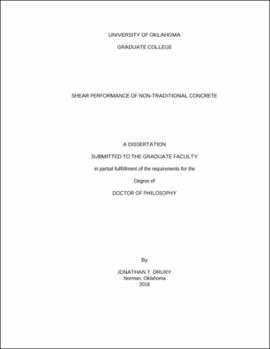| dc.description.abstract | Concrete is the second most consumed material in the world, second only to water. Concrete has been around in different forms for centuries, and science and technology continually push the previously believed limits. Two such types of concrete are self-consolidating concrete (SCC) and cement-limiting concrete. While each is vastly different from the other, they present similar problems to designers and engineers. Practitioners have implemented new technologies such as fiber reinforcement to combat issues with these concretes, but the overall behavior and internal mechanism of these concretes are not thoroughly understood. This study investigated the shear behavior of seven different concrete types: conventional concrete with micro-fibers, conventional concrete with micro-fibers and macro-fibers, cement-limiting concrete, cement-limiting concrete with micro-fibers, cement-limiting concrete with micro-fibers and macro-fibers, SCC, SCC with macro-fibers, and compared their behavior to the behavior of conventional concrete. Additionally, a newly proposed push-off test method was developed, investigated, and compared to historic methods.
The experimental programs consisted of 15 full-scale shear beams without shear reinforcement in the test regions (3 with conventional concrete, 6 with cement-limiting concrete, and 6 with SCC), 24 push-off specimens (3 for each of the eight concrete mixtures investigated), and many small-scale specimens to capture the fresh and hardened properties of the concrete mixtures. The shear beams were tested under a simply supported four-point loading condition.
Results of this study showed that fiber reinforced concrete has more variable performance, but that fiber reinforcement can mitigate the negative performance aspects of SCC and cement-limiting concrete. It was shown that micro-fibers amplified the cohesion performance of existing concrete matrixes, but that macro-fiber tend to govern the performance of a concrete mixture. It was shown than that the optimized gradation of the cement-limiting concrete provided the highest aggregate interlock, but that aggregate interlock is not the best predictor of shear transfer performance between two concrete surfaces. Lastly, this study showed that the proposed push-off test is not only an acceptable method for analyzing aggregate interlock, but it is an improvement due to the ability to obtain more data from it, improved quality control, simplified analysis, and repeatability of the outcomes. | en_US |
